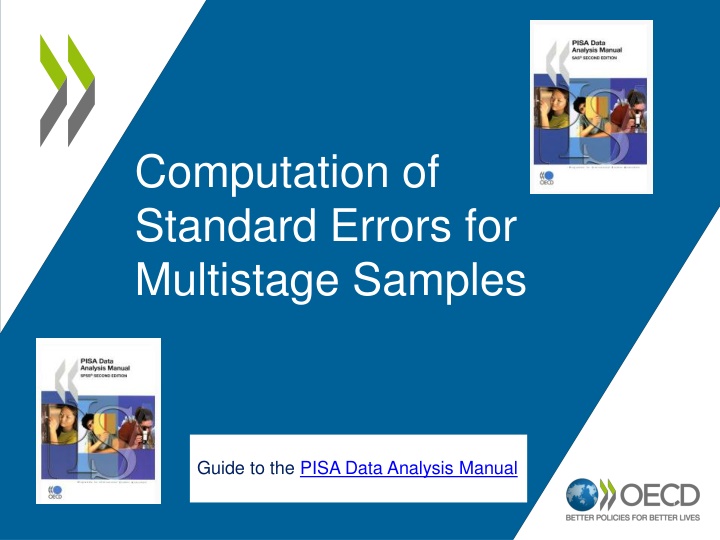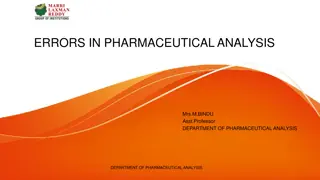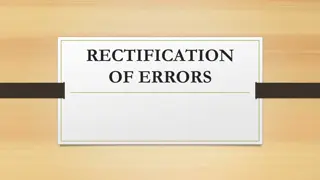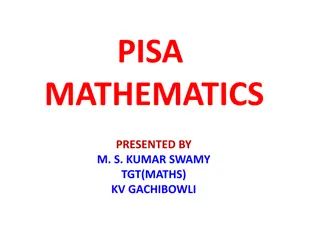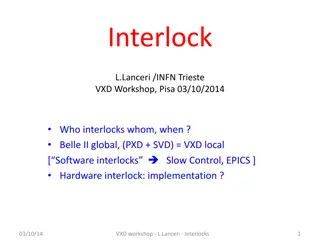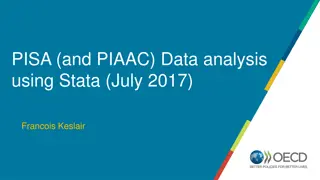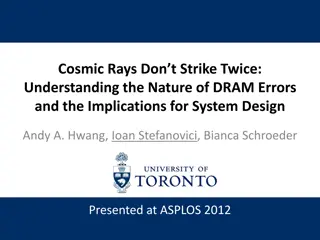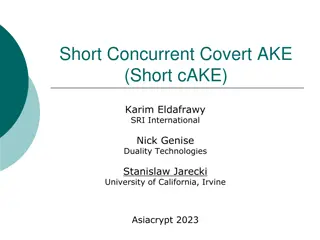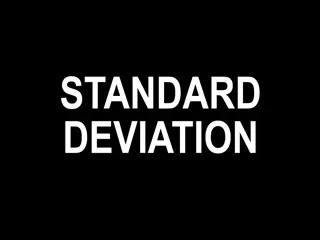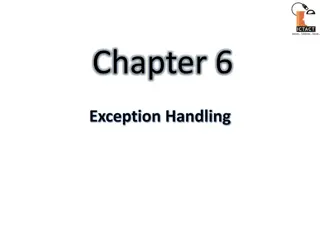Computation of Standard Errors in PISA Data Analysis
In PISA and IEA studies, results are derived from samples, leading to estimated statistics like means, standard deviations, and regression coefficients. Standard errors quantify the uncertainty resulting from the sampling process. Discover more about standard errors, confidence intervals, and p-values in educational assessments.
Download Presentation

Please find below an Image/Link to download the presentation.
The content on the website is provided AS IS for your information and personal use only. It may not be sold, licensed, or shared on other websites without obtaining consent from the author.If you encounter any issues during the download, it is possible that the publisher has removed the file from their server.
You are allowed to download the files provided on this website for personal or commercial use, subject to the condition that they are used lawfully. All files are the property of their respective owners.
The content on the website is provided AS IS for your information and personal use only. It may not be sold, licensed, or shared on other websites without obtaining consent from the author.
E N D
Presentation Transcript
Computation of Standard Errors for Multistage Samples Guide to the PISA Data Analysis Manual 1
What is a Standard Error (SE) In PISA, as well as in IEA studies, results are based on a sample Published statistics are therefore estimates Estimates of the means, of the standard deviations, of the regression coefficients The uncertainty due to the sampling process has to be quantified Standard Errors, Confidence Intervals, P Value OECD (2001). Knowledge and Skills for Life: First Results from PISA 2000. Paris: OECD.
What is a Standard Error (SE) Let us imagine a teacher willing to implement the mastery learning approach, as conceptualized by B.S. Bloom. Need to assess students after each lesson With 36 students and 5 lessons per day
What is a Standard Error (SE) Description of the population distribution 1 N 1 N = i = = + + + + + + = 5 ( 6 6 .... 14 14 15 ) 10 ix 36 1 36 1 N 1 210 N = i = i = = = = 2 2 2 ( ) ( 10 ) . 5 833 x x i i 36 36 1 1 The teacher decides to randomly draw 2 student s tests for deciding if a remediation is needed How many samples of 2 students from a population of 36 students?
What is a Standard Error (SE) Number of possible sample of size n from a population of size N n ! N = = n N C N ( )! ! N n n 10,000,000,000 9,000,000,000 Number of sample 8,000,000,000 7,000,000,000 6,000,000,000 5,000,000,000 4,000,000,000 3,000,000,000 2,000,000,000 1,000,000,000 0 Sample Size If the thickness of a coin is 1 mm, then 1 billion of coins on the edge corresponds to 1000 km
What is a Standard Error (SE) Graphical representation of the population mean estimate for all possible samples
What is a Standard Error (SE) The distribution of sampling variance on the previous slide has: a mean of 10 ) 6 * 4 ( ) 5 . 5 * 2 ( ) ( = + + 2 ( + ......( 4 * 14 ) * 14 ) 5 . = 10 630 a Standard Deviation (STD) of 1.7 ) 10 5 . 5 ( 2 ) ( = 5 . 5 ( + 6 ( + + 2 2 2 2 10 ) 10 ) .......( 14 5 . 10 ) 630 1785 = . 1 = 68 ) ( 630 The STD of a sampling distribution is denoted Standard Error (SE)
What is a Standard Error (SE) The sampling distribution on the mean looks like a normal distribution
What is a Standard Error (SE) Let us count the number of samples with a mean included between [(10-1.96SE);(10+1.96SE)] [(10-3.30);(10+3.30)] [6.70;13.30] There are: 6+28+38+52+60+70+70+70+60+52 +38+28+16=598 samples, thus 94.9 % of all possible samples With a population N(10, 5, 83), 95% of all possible samples of size 2 will have a population mean estimate included between 6.70 and 13.30
What is a Standard Error (SE) Sampling distribution of the mean estimates of all possible samples of size 4 5000 4500 4000 3500 3000 2500 2000 1500 1000 500 0 6.00 6.75 7.50 8.25 9.00 9.75 10.50 11.25 12.00 12.75 13.50
What is a Standard Error (SE) The distribution of sampling variance on the previous slide has: a mean of 10 3 ( + + + ) 6 * 10 ( . 6 * 25 ) ......( 10 * 13 75 . ) 3 ( 14 * ) = = 10 ) ( 58905 a Standard Deviation of 1.7 6 ( 6 ( + 6 ( + + 2 2 2 2 10 ) 10 ) 10 ) .......( 14 10 ) = . 1 = 2 ( 335 ) 58905 . 1 = 155 ) (
What is a Standard Error (SE) Distribution of the scores versus distribution of the mean estimates
What is a Standard Error (SE) The sampling variance of the mean is inversely proportional to the sample size: If two students are sampled, then the smallest possible mean is 5.5 and the highest possible mean is 14.5 If four students are sampled, it ranges from 6 to 14 If 10 students are sampled, it ranges from 7 to 13 The sampling variance is proportional to the variance: If the score are reported on 20, with a sample of size 2, then it ranges from 5,5 to 14,5 If the score are reported on 40 (multiplied by 2) then it ranges from 11 to 29
What is a Standard Error (SE) Individual 1 Individual 2 Individual 3 Individual 4 Mean estimates Sample 1 X11 X12 X13 X14 X15 X16 X17 X18 X19 X21 X22 X23 X24 X25 X26 X27 X28 X29 X31 X32 X33 X34 X35 X36 X37 X38 X39 X41 X42 X43 X44 X45 X46 X47 X48 X49 1 2 3 4 5 6 7 8 9 Sample 2 Sample 3 Sample 4 Sample 5 Sample 6 Sample 7 Sample 8 Sample 9 Sample X X1x X2x X3x X4x x = 2 ( 2 ) n 1 n 1 = i ( ) X i
What is a Standard Error (SE) = 2 2 = a 2 ( 2 2 ( . ) ( u n 1 = . ) ) a X X ( ) X i n 1 i 1 = + + 2 ( 2 ( 2 ( 2 cov( , ) A B = 2 2 + ) ) ) A B A B ) ( u n 2 n = ( ) X i 1 i 1 1 n n = n = = + 2 2 ( 2 cov( , ) X X ) ( ) u X i j 2 n i = + 1 1 1 i i j i 2 1 = = 2 2 n ) ( u 2 n n 2 = = = 2 SE ) ( ) ( u u n
What is a Standard Error (SE) As we don t know the variance in the population, the SE for a mean of as obtained from a sample is calculated as 2 = = 2 ( ( ) ) n n similarly, the SE for a percentage P is calculated as PQ SEP= n
What is a Standard Error (SE) Linear regression assumptions: Homoscedasticity the variance of the error terms is constant for each value of x Linearity the relationship between each X and Y is linear Error Terms are normally distributed Independence of Error Terms successive residuals are not correlated If not, the SE of regression coefficients is biased
What is a Standard Error (SE) With a multistage sample design, errors will be correlated
Standard Errors for multistage samples Multistage samples are usually implemented in International Surveys in Education: schools (PSU=primary sampling units) classes students If schools/classes / students are considered as infinite populations and if units are selected according to a SRS procedures, then: 2 2 2 | cla | | cla n . sch stu sch n . = + + 2 ( sch ) n . n n n | | | | sch sch Cla sch sch Cla sch stu cla sch
Standard Errors for multistage samples PISA: 2 stage samples : schools and then students + 2 2 ( ) 2 B + 2 cla n sch stu cla = = + 2 ( sch ) 2 B 2 W n n / sch sch stu sch IEA: 2 stage samples : schools and then 1 class per selected school 2 B + + 2 2 2 ( ) = sch cla sch stu n . cla = + 2 ( 2 B 2 W ) 1 . n n / sch sch stu cla
Standard Error for multistage samples Three fictitious examples in PISA 2 stud 2 sch 1000 9000 | sch = + = + = . 1 + = 2 ( . 6 66 71 . 8 38 ) 150 150 ( ).( 35 ) 150 5250 2 stud 2 sch 3000 7000 | sch = + = + = . 1 + = 2 ( 20 33 21 33 . ) 150 150 ( ).( 35 ) 150 5250 2 stud 2 sch 6000 4000 | sch = + = + = + = 2 ( 40 . 0 76 40 76 . ) 150 150 ( ).( 35 ) 150 5250 If considered as a SRS or random assignment to schools 2 10000 = = . 1 = 2 ( 90 ) 5250 n
Standard Error for multistage samples = = 2 2 10000 10000 = . 0 60 = . 0 20 12.00 12.00 10.00 10.00 8.00 8.00 5 10 15 20 25 5 10 15 20 25 Standard Error Standard Error 6.00 6.00 4.00 4.00 2.00 2.00 0.00 0.00 50 70 90 110 130 150 170 190 210 230 250 270 290 50 70 90 110 130 150 170 190 210 230 250 270 290 Number of schools Number of schools 24
Standard Error for multistage samples Variance Decomposition for Reading Literacy in PISA 2000 12000 10000 8000 6000 4000 2000 0 ISL SWE FIN NOR ESP IRL CAN KOR DNK AUS NZL GBR RUS LUX USA LVA BRA JPN PRT LIE MEX FRA CHE CZE ITA GRC POL HUN AUT DEU BEL 25
Standard Error for multistage samples Impact of the stratification variables on sampling variance + ( ) ( ) N N = 1 1 2 2 N + ( ) ( ) N N N1, N2considered as constant = 2 ( 2 1 1 2 2 ) N + + 2 2 ( 2 2 2 ( 2 cov( , ) N N N N Independent samples so COV=0 1 ) ) 1 1 2 2 = 1 2 2 N + 2 2 ( 2 2 2 ( N N 1 ) ) = 1 2 2 N
Standard Error for multistage samples Effect Sum of Squares 2500 Degree of Freedom L-1 (1) Mean square 2500 Gender (50F+50G) 2 W ERROR 7500 N-L (98) 76.53 2 TOTAL 10000 N-1 (99) 101.01 2 101 01 . = = . 1 = 005 ) ( 100 n 76 53 . 76 53 . + + 2 ( 2 ( 50 50 = = 7653 , 0 . 0 875 ) ) = = = 2 7653 . 0 F M ) ( + 4 4 F M 2 27
Standard Error for multistage samples School and within school variances of the student performance in reading, intraclass correlation with and without control of the explicit stratification variables (OECD, PISA 2000 database) Rho under control of stratification School variance Within school variance School variance under control of stratification Country Rho AUT 6356 4243 624 0.60 0.13 BEL 7050 4724 3489 0.60 0.42 CHE 4517 5909 3119 0.43 0.35 CZE 4812 4203 604 0.53 0.13 DNK 1819 7970 1696 0.19 0.18 ESP 1477 5649 823 0.21 0.13 FIN 998 7096 869 0.12 0.11 FRA 4181 4219 910 0.50 0.18 GBR 2077 7637 1990 0.21 0.21 GRC 4995 4907 3619 0.50 0.42 HUN 6604 3230 4638 0.67 0.59 IRL 1589 7349 1495 0.18 0.17 ISL 652 7884 563 0.08 0.07 ITA 4719 4028 2031 0.54 0.34
Standard Error for multistage samples Consequences of considering PISA samples as simple random samples In most cases, underestimation of the sampling variance estimates Non significant effect will be reported as significant How can we measure the risk? Computation of the Type I error
Standard Error for multistage samples Consequences : Type I error underestimation
Standard Error for multistage samples Consequences : Type I error underestimation Sampling Variance Standard Error Ratio Ratio x Z score Type I Error Unbiased estimate 24 4.90 20 4.47 0.07 0.91 1.79 16 4.00 0.11 0.82 1.60 Biased estimate 12 3.46 0.17 0.71 1.38 8 2.83 0.26 0.58 1.13 4 2.00 0.42 0.41 0.80
Standard Error for multistage samples 2 ( Sampling Design Effect ) = SDE reel 2 ( ) SRS
Standard Error for multistage samples Sampling design effect in PISA 2000 Reading Country SDE Type I Country SDE Type I Australia 5.90 Korea 5.89 0.42 0.42 Austria 3.10 Latvia 10.16 0.27 0.54 Belgium 7.31 Liechtenstein 0.48 0.47 0.00 Brazil 6.14 Luxembourg 0.73 0.43 0.02 Canada 9.79 Mexico 6.69 0.53 0.45 Czech Republic 3.18 Netherlands 3.52 0.27 0.30 Denmark 2.36 New Zealand 2.40 0.20 0.21 Finland 3.90 Norway 2.97 0.32 0.26 France 4.02 Poland 7.12 0.33 0.46 Germany 2.36 Portugal 9.72 0.20 0.53 Greece 12.04 Russian Federation 13.53 0.57 0.59 Hungary 8.64 Spain 6.18 0.50 0.43 Iceland 0.73 Sweden 2.32 0.02 0.20 Ireland 4.50 Switzerland 10.52 0.36 0.55 Italy 1.90 United Kingdom 5.97 0.16 0.42 Japan 19.28 United States 17.29 0.66 0.64
Standard Error for multistage samples Factors influencing the SE other than the sample size School Variance: depending on the variable Usually high for performance Low for other variables Efficiency of the stratification variables A stratification variable can be efficient for some variables and not for others Population parameter estimates
Standard Error for multistage samples A few examples (PISA2000, Belgium) Mean estimate Performance in reading: Social Background (HISEI): Enjoyment for Reading: Regression analyses: Reading = HISEI + GENDER Intercept HISEI GENDER Logistic regression Level (0/1 Reading below or above 500) =HISEI Intercept SDE= 2.39 HISEI SDE=2.09 Rho=0.60 Rho= 0.24 Rho=0.10 SDE=7.19 SDE=3.45 SDE=1.86 SDE= 5.50 SDE=3.78 SDE=3.91
Standard Error for multistage samples Very few mathematical solutions for the estimation of the sampling variance for multistage samples For mean estimates under the condition Simple Random Sample (SRS) and stratified Probability Proportional to Size (PPS) sample but with no stratification variables No mathematical solutions for other statistics Use of replication methodologies for the estimation of sampling variance For SRS: Jackknife: n replications de n-1 cases Bootstrap : an infinite number of samples of n cases randomly drawn with replacement.
Replication methods for SRS n n 1 n n 1 n n = i = i Jackknife for SRS ) = = 2 2 2 2 ( ( ) ( ) jack i ( ) ( ) jack i i 1 1 Student 1 2 3 4 5 6 7 8 9 10 Mean Value 10 11 12 13 14 15 16 17 18 19 14.50 Replication 1 0 1 1 1 1 1 1 1 1 1 15.00 Replication 2 1 0 1 1 1 1 1 1 1 1 14.88 Replication 3 1 1 0 1 1 1 1 1 1 1 14.77 Replication 4 1 1 1 0 1 1 1 1 1 1 14.66 Replication 5 1 1 1 1 0 1 1 1 1 1 14.55 Replication 6 1 1 1 1 1 0 1 1 1 1 14.44 Replication 7 1 1 1 1 1 1 0 1 1 1 14.33 Replication 8 1 1 1 1 1 1 1 0 1 1 14.22 Replication 9 1 1 1 1 1 1 1 1 0 1 14.11 Replication 10 1 1 1 1 1 1 1 1 1 0 14.00
Replication methods for SRS Jackknife for SRS Estimation of the SE by replication n 1 n n = i ) = 2 2 ( ( ) jack i 1 9 = + + + + 2 ( 2 2 2 2 15 ( 00 . 14 50 . ) 14 ( 88 . 14 50 . ) .... 15 ( 11 . 14 50 . ) 14 ( 00 . 14 50 . ) ) 10 9 = = 2 ( 018519 . 1 ( 10 ) 9167 . 0 ) Estimation by using the mathematical formula 2 1 1 n ( ) = i = = + + + + = 2 2 2 2 2 10 ( 14 ) 5 . 11 ( 14 ) 5 . ... 18 ( 14 ) 5 . 19 ( 14 ) 5 . . 9 17 ix 1 9 n 1 2 . 9 17 = = = 2 ( . 0 917 ) 10 n
Replication methods for SRS n n n n = = = = x x x x x i i i i i n 1 1 x x = 1 i = = + = + 1 1 1 i i i i 1 i x ( ) ( ) ( ) ( ) i i 1 1 1 1 n n n n n n n n 1 i ( ) ( ) n 1 1 1 n 1 x n n n = = = + = 1 i x x x ( ) ( ) i i i 1 1 1 n n n n n n 1 1 i i 1 1 1 )( 1 ) ( ( ) ) )( 1 )( ) )( ) = = + = 1 1 x n n x n n x ( ( ( i i i 1 n n n ( ) 1 )( 1 ) 2 2 = x ( ( ) i i 2 n n ( ( ) = 2 x i ( ) n 1 n 1 1 ( ) = = 2 2 = = = 2 1 i x ( ) ) ( ) ( ) ( ) i i 2 1 1 1 n n n 1 n 1 1 i i ( ) ( ) 2 ( ) 1 1 1 n n n = 2 = = = 2 2 ( ) ( ) jack i 1 n n n n 1 i
Replication methods for SRS 1 n = i Bootstrap for SRS = 2 2 ( ) ( ) ( ) boot i i 1 G 1 Student 1 2 3 4 5 6 7 8 9 10 Mean Value 10 11 12 13 14 15 16 17 18 19 14.50 Structure 1 1 1 1 1 1 1 1 1 1 1 14.50 Structure 2 2 1 1 1 1 1 1 1 1 0 From 13.7 to 15.4 Structure 3 2 2 1 1 1 1 1 1 0 0 From 12.9 to 16.1 0 0 0 0 Structure 5 1 1 1 1 1 0 0 0 0 Structure 6 1 1 1 1 0 0 0 0 0 0 0 Structure 7 1 1 1 0 0 0 0 0 0 0 Structure 8 1 1 0 0 0 0 0 0 0 0 Structure 9 1 0 0 0 0 0 0 0 0 0 Structure 10 From 10 to 19
Replication methods for multistage sample Jackknife for unstratified Multistage Sample Replicate R1 R2 R3 R4 R5 R6 R7 R8 R9 R10 School 1 0.00 1.11 1.11 1.11 1.11 1.11 1.11 1.11 1.11 1.11 School 2 1.11 0.00 1.11 1.11 1.11 1.11 1.11 1.11 1.11 1.11 School 3 1.11 1.11 0.00 1.11 1.11 1.11 1.11 1.11 1.11 1.11 School 4 1.11 1.11 1.11 0.00 1.11 1.11 1.11 1.11 1.11 1.11 School 5 1.11 1.11 1.11 1.11 0.00 1.11 1.11 1.11 1.11 1.11 School 6 1.11 1.11 1.11 1.11 1.11 0.00 1.11 1.11 1.11 1.11 School 7 1.11 1.11 1.11 1.11 1.11 1.11 0.00 1.11 1.11 1.11 School 8 1.11 1.11 1.11 1.11 1.11 1.11 1.11 0.00 1.11 1.11 School 9 1.11 1.11 1.11 1.11 1.11 1.11 1.11 1.11 0.00 1.11 School 10 1.11 1.11 1.11 1.11 1.11 1.11 1.11 1.11 1.11 0.00 Each replicate= contribution of a school
Replication methods for SRS Jackknife for stratified Multistage Sample Pseudo- stratum School R1 R2 R3 R4 R5 1 1 2 1 1 1 1 1 2 0 1 1 1 1 2 3 1 0 1 1 1 2 4 1 2 1 1 1 3 5 1 1 2 1 1 3 6 1 1 0 1 1 4 7 1 1 1 0 1 4 8 1 1 1 2 1 5 9 1 1 1 1 2 5 10 1 1 1 1 0 Each replicate= contribution of a pseudo stratum
Replication methods for multistage sample Balanced Replicated Replication Pseudo- stratum School R1 R2 R3 R4 R5 R6 R7 R8 1 1 2 2 2 2 2 2 2 2 1 2 0 0 0 0 0 0 0 0 2 3 2 0 2 0 2 0 2 0 2 4 0 2 0 2 0 2 0 2 3 5 2 2 0 0 2 2 0 0 3 6 0 0 2 2 0 0 2 2 4 7 2 0 0 2 2 0 0 2 4 8 0 2 2 0 0 2 2 0 5 9 2 2 2 2 0 0 0 0 5 10 0 0 0 0 2 2 2 2 Each replicate= an estimate of the sampling variance
Replication methods for multistage sample How to form the pseudo-strata, i.e. how to pair schools? ID Size From To SAMPLED Within explicit strata, with a systematic sampling procedure, schools are sequentially selected. Pairs are formed according to the sequence School 1 with School 5 School 8 with School 10 1 15 1 15 1 2 20 26 35 0 3 25 36 60 0 4 30 61 90 0 5 35 91 125 1 6 40 126 165 0 7 45 166 210 0 8 50 211 260 1 9 60 261 320 0 10 80 321 400 1 Total 400
Replication methods for multistage sample How to form the pseudo-strata, i.e. how to pair schools? IEA TIMSS / PIRLS procedure PISA procedure ID Participation Pseudo- Stratum ID Participation Pseudo- Stratum 14 1 1 14 1 1 21 1 1 21 1 1 35 1 2 35 1 2 56 0 56 0 2 78 1 2 78 1 3 99 1 3 99 1 3 103 0 103 0 4 115 1 3 115 1 4 126 1 4 126 1 5 137 1 4 137 1 5
Replication methods for multistage sample Stratum 1 Stratum 2 Stratum 3 Stratum 4 Balanced Replicated Replication With L pseudo-strata, there are 2L possible combinations If 4 strata, then 16 combinations Same efficiency with an Hadamard Matrix of Rank 4 1 1 1 1 1 2 1 1 1 2 3 1 1 2 1 4 1 2 1 1 5 2 1 1 1 6 1 1 2 2 7 1 2 1 2 8 2 1 1 2 9 1 2 2 1 10 2 1 2 1 11 2 2 1 1 12 1 2 2 2 13 2 1 2 2 14 2 2 1 2 15 2 2 2 1 16 2 2 2 2
Replication methods for multistage sample Hadamard Matrix Combination 1 2 3 4 1 1 1 1 1 -1 1 -1 1 1 -1 -1 1 -1 -1 1 Each row is orthogonal to all other rows, i.e. the sum of the products is equal to 0. Selection of school according to this matrix
Replication methods for multistage sample H H = n n H2 n H H n n + + 1 1 = H 2 + 1 1 + + + + 1 1 1 1 + + 1 1 1 1 = H + + 1 1 1 1 4 + + 1 1 1 1
Replication methods for multistage sample Fays method Pseudo- stratum School R1 R2 R3 R4 R5 R6 R7 R8 1 1 1.5 1.5 1.5 1.5 1.5 1.5 1.5 1.5 1 2 0.5 0.5 0.5 0.5 0.5 0.5 0.5 0.5 2 3 1.5 0.5 1.5 0.5 1.5 0.5 1.5 0.5 2 4 0.5 1.5 0.5 1.5 0.5 1.5 0.5 1.5 3 5 1.5 1.5 0.5 0.5 1.5 1.5 0.5 0.5 3 6 0.5 0.5 1.5 1.5 0.5 0.5 1.5 1.5 4 7 1.5 0.5 0.5 1.5 1.5 0.5 0.5 1.5 4 8 0.5 1.5 1.5 0.5 0.5 1.5 1.5 0.5 5 9 1.5 1.5 1.5 1.5 0.5 0.5 0.5 0.5 5 10 0.5 0.5 0.5 0.5 1.5 1.5 1.5 1.5
Replication methods for multistage sample General formula G = c ) 2 ( 2 ( ) ( ) i = 1 i BRR / Fay : each replicate is an estimate of the sampling variance C = average Same number of replicate for each country JK2 : each replicate corresponds of the pseudo-stratum to the sampling variance estimate C = sum Possibility of different number of replicates
